Boston is the capital of Massachusetts and the largest city in New England. It is also New England’s leading business, financial, government, and transportation center. Boston lies along the Atlantic coast in eastern Massachusetts. Its sheltered harbor helps make the city a busy seaport. In addition to its commercial importance, the Boston area is a center of education, medicine, and technology. Its many outstanding universities, libraries, and other centers of learning have earned it the nicknames the Hub of the Universe and the Athens of America.
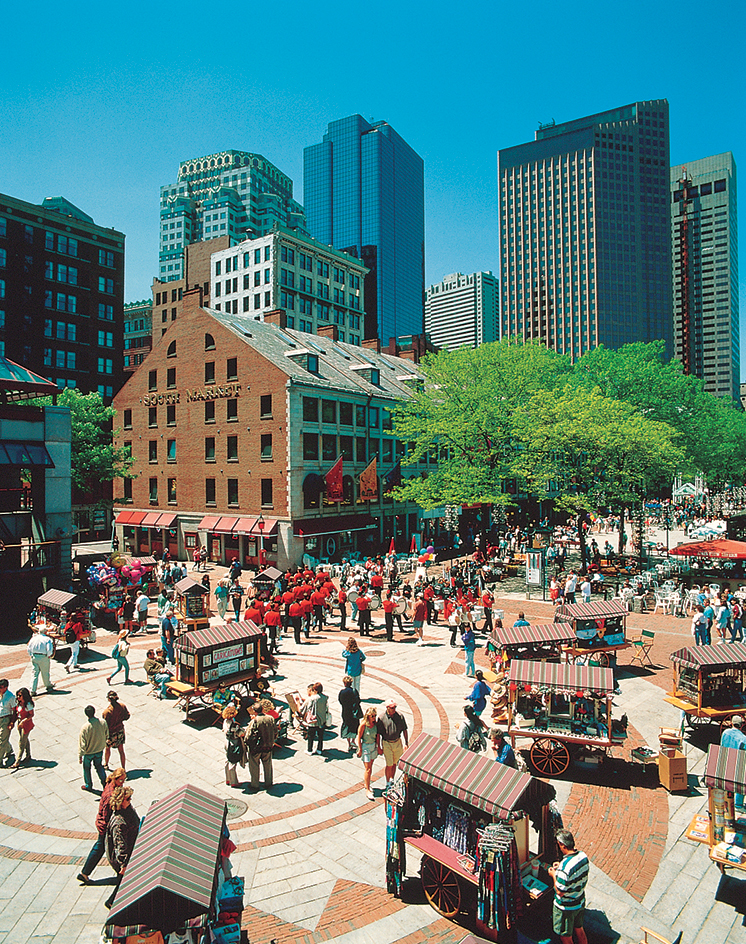
Boston is one of the oldest and most historic cities in the United States. English Puritans founded it in 1630. They named it after the town of Boston, England, where many of them had lived. Boston grew rapidly in size and wealth during the 1600’s and 1700’s because it served as the American Colonies’ chief seaport for ships bound for England and the Caribbean. Elegant houses and stately churches that date from the 1700’s still stand along Boston’s narrow, winding streets.
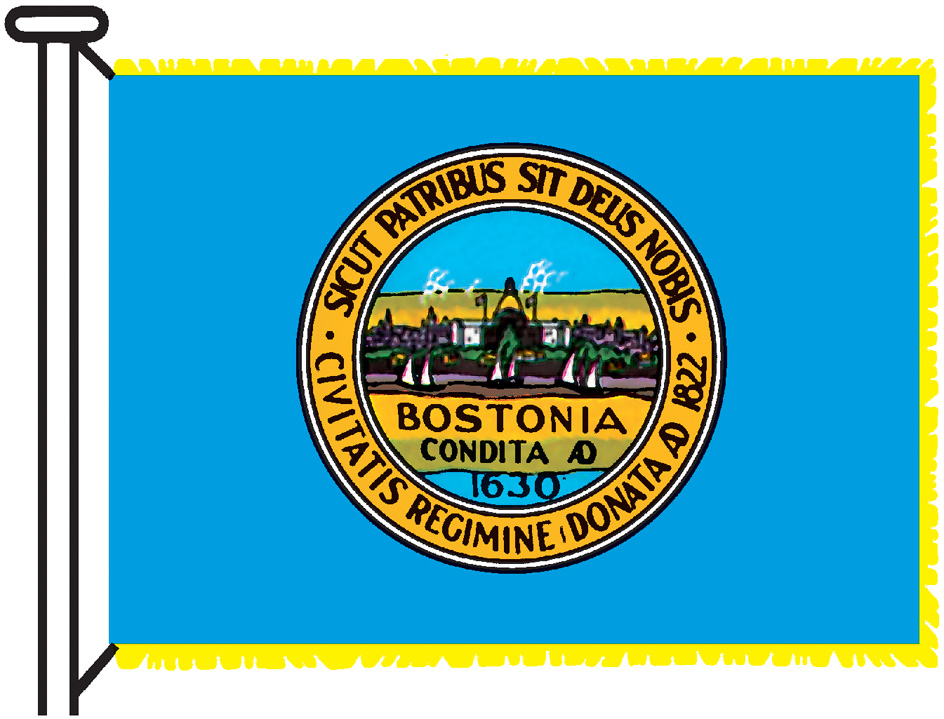
Boston is known as the Cradle of Liberty because it was the birthplace of the Revolutionary War in America (1775-1783). The Boston Massacre, the Boston Tea Party, and several major battles of the Revolutionary War occurred in or near the city. Every year, large numbers of tourists come to Boston to see Paul Revere’s house, the Bunker Hill Monument, Faneuil Hall, the Old State House, and other reminders of the revolutionary period.
After the Revolutionary War and through the 1800’s, Boston continued to be a leading port. Also, the city’s industries grew rapidly and made it an important manufacturing center. The city began to receive many immigrants. In the mid-1800’s, for example, hundreds of thousands of Irish people poured into Boston to escape starvation in Ireland, where the potato crop had failed.
In the last half of the 1900’s, Boston experienced many of the same problems faced by most other major United States cities. These problems included poverty, racial unrest, declining neighborhoods, and a loss of families and businesses to the suburbs. To ease some of its problems, the city undertook a huge urban renewal program in the early 1970’s. The construction of modern apartments, offices, and stores and gradual improvement in the city’s public schools helped attract families and businesses back to the city. In the late 1900’s and early 2000’s, the downtown area became the focus of a number of development projects.
The city
Boston covers 48 square miles (124 square kilometers). The Neponset River borders the city on the southeast. The Charles, Chelsea, and Mystic rivers separate Boston from several suburbs to the north and west.
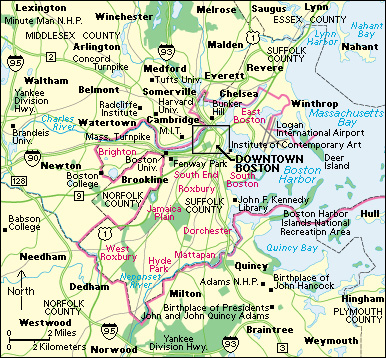
Since its founding in 1630, Boston has grown to about 40 times its original size. The English founded the city on a 783-acre (317-hectare) peninsula between the Charles River and Boston Harbor. The Indigenous peoples who lived in the region called the peninsula Shawmut. In the mid-1800’s, the city added 3,000 acres (1,200 hectares) of land to the Shawmut peninsula by filling in some of the shallow coastal waters. Over the years, Boston also expanded by annexing many nearby towns. Most of the city’s neighborhoods, such as Charlestown, Dorchester, Roxbury, and South Boston, were once independent.
Boston has many neighborhoods. They include Downtown Boston, Back Bay, Beacon Hill, the North End, South Boston, East Boston, Charlestown, Brighton-Allston, Roxbury, Dorchester, the South End, Mattapan, Jamaica Plain, Hyde Park, and West Roxbury.
Downtown Boston
occupies the center of the Shawmut peninsula. It is a blend of historic landmarks, old factories and office buildings, and glass-and-steel skyscrapers. The area’s parks, stores, historic sites, and other attractions draw millions of visitors yearly.
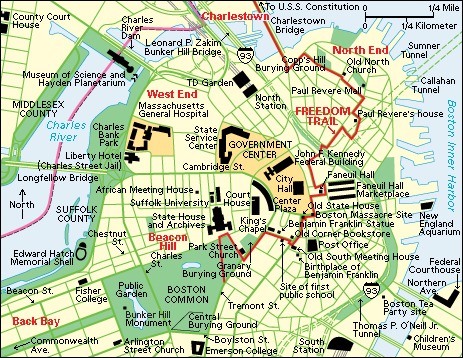
At the north end of the downtown area stands Government Center, a 60-acre (24-hectare) complex of offices, shops, and plazas. The center includes City Hall, which was completed in 1969, and the twin towers of the John F. Kennedy Federal Office Building. East of City Hall is historic Faneuil Hall and the Faneuil Hall Marketplace. Bostonians met in Faneuil Hall before the Revolutionary War to protest British tax and trade policies. The marketplace was developed in the 1970’s from the old Quincy Market, South Market, and North Market. It includes numerous shops, food stalls, and restaurants. Boston’s financial district lies south of Government Center along Congress, Federal, and Devonshire streets. A few blocks west, shoppers crowd the department stores along Washington Street.
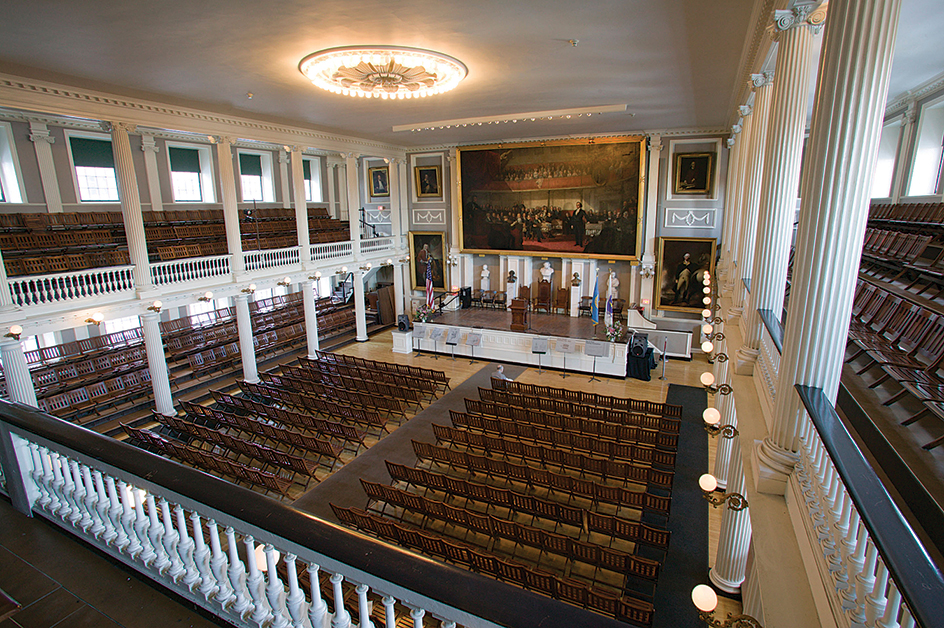
Boston’s famous Freedom Trail begins in the downtown area and extends into the North End. The trail, a 3-mile (4.8-kilometer) marked path, passes many of the city’s historic landmarks. Stops on the Freedom Trail include the site of the Boston Massacre, in which British troops fired on civilians, and the Old South Meeting House, where colonists met before the Boston Tea Party, a protest against a British tax on tea. Many of these landmarks and others from the revolutionary era are part of the Boston National Historical Park.
Boston Common, the nation’s oldest public park, covers 45 acres (18 hectares) along the western edge of downtown. John Winthrop, the leader of Boston’s founders, set aside the land in 1634 as a military training field and as a public cattle pasture. Women found guilty of witchcraft in the late 1600’s were hanged in the Common. The American statesman and inventor Benjamin Franklin grazed his family’s cow there during his boyhood. Today, the park is a favorite meeting place for open-air political rallies. Just west of the Common lies Boston’s formal Public Garden. During the spring and summer, many people like riding in the graceful swan-shaped paddleboats on the Public Garden’s lake.
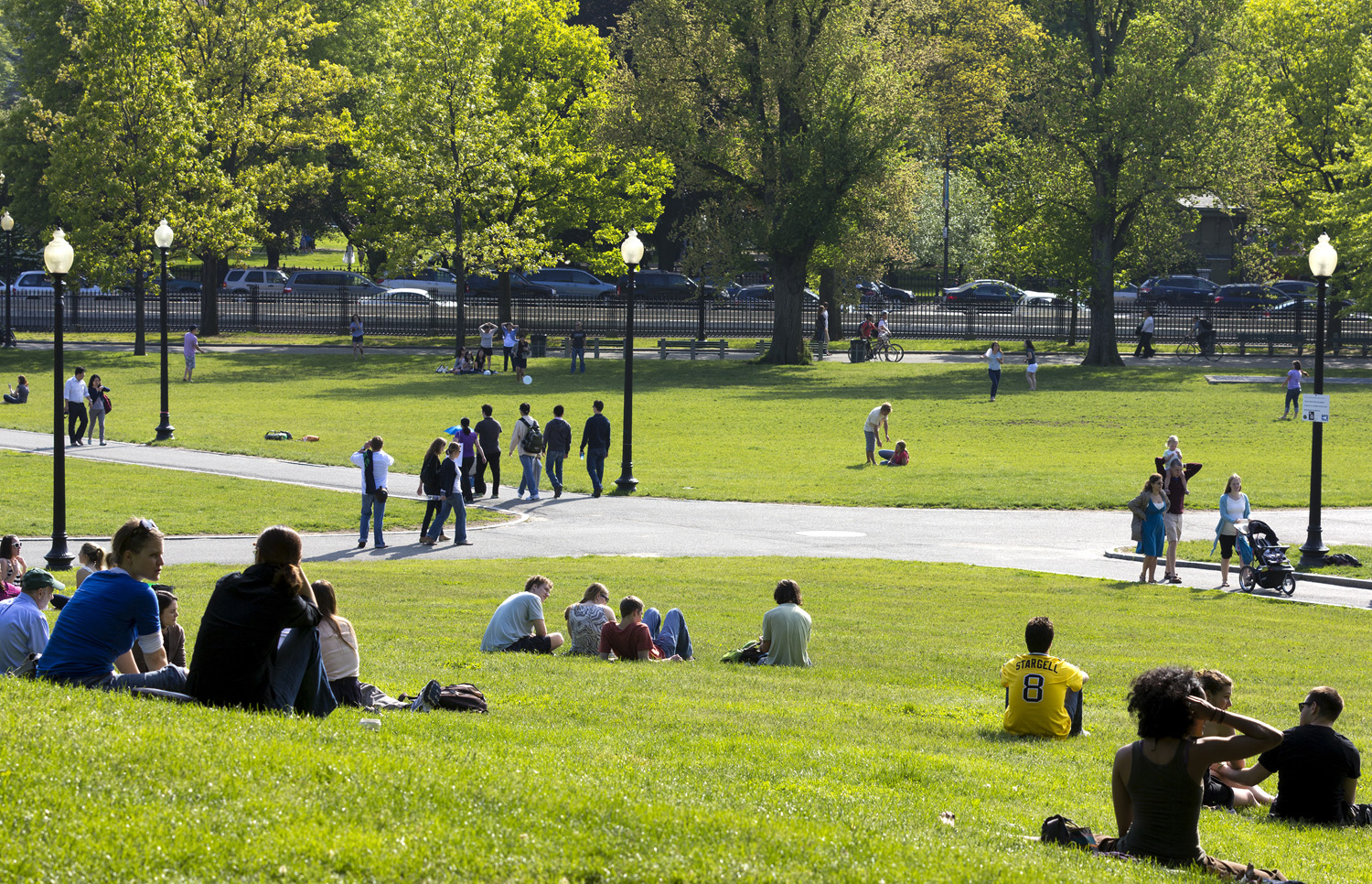
Back Bay
stretches from the Public Garden west to the suburb of Brookline. The Back Bay area was a marshy section of the Charles River until the city’s landfill project created the community in the mid-1800’s. Today, long rows of beautiful old townhouses (houses that share a common wall) stand along the neighborhood’s treelined streets. Many of Boston’s most expensive stores and finest restaurants are on fashionable Boylston and Newbury streets in Back Bay.
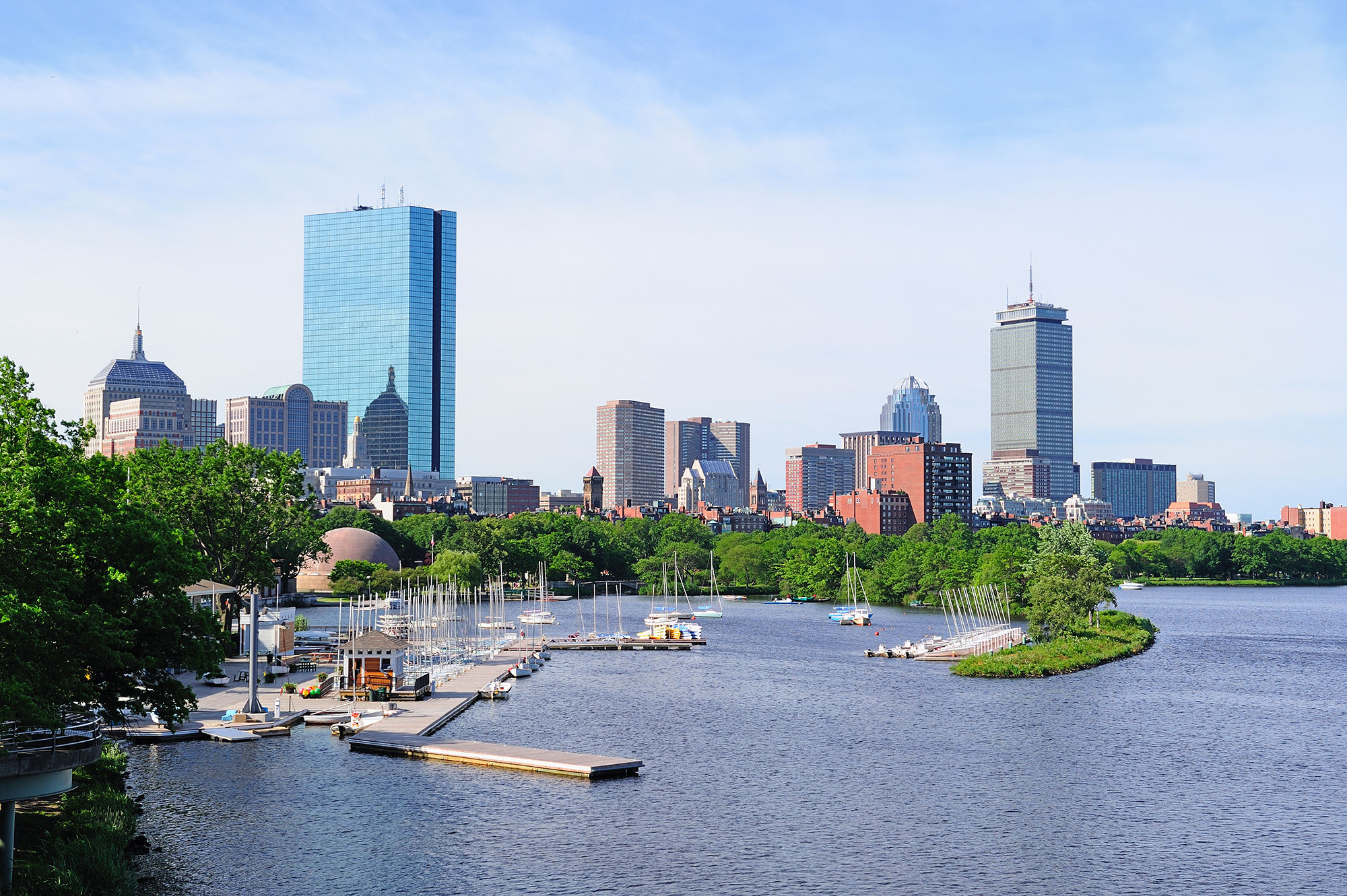
Wealthy families lived in the Back Bay area until the 1920’s, when they began to move to Boston’s northern and western suburbs. Many of the townhouses were then converted into apartments. Today, Back Bay is a popular neighborhood among college students, young unmarried workers, and some families.
Two high-rise complexes stand out against the Back Bay skyline. The Prudential Center on Boylston Street includes the 52-story Prudential Tower, two other office towers, and a large shopping mall. The center is part of a complex that also includes hotels, residential buildings, and the Hynes Convention Center. A few blocks northeast of Prudential Center lies Copley Square. In the square stand the main branch of the Boston Public Library and the 62-story building at 200 Clarendon Street (formerly the John Hancock Tower). The tower ranks as the tallest skyscraper in New England. Massive Trinity Church also stands in Copley Square. The church was designed by the American architect Henry Hobson Richardson in the 1870’s. It is considered a national landmark.
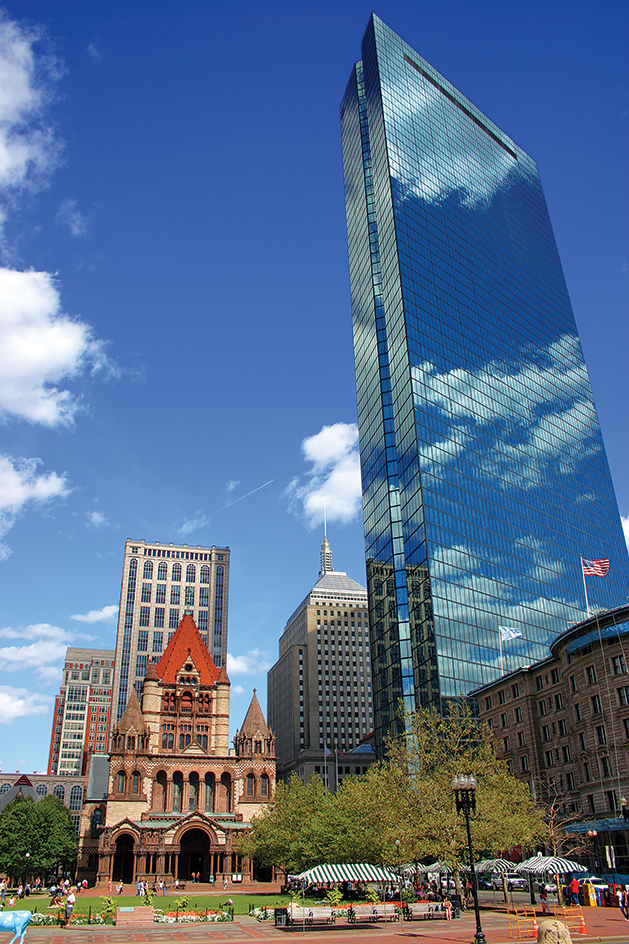
Beacon Hill
rises north of Boston Common. During the 1600’s, the hill served as a beacon station for signaling ships. Since the late 1700’s, Beacon Hill has been a fashionable neighborhood with gaslights and narrow, cobblestone streets. Some of Boston’s oldest and most distinguished families live in the neighborhood. Elegant red-brick townhouses surround a lovely park in a charming section called Louisburg Square. The State House, the gold-domed meeting place of the Massachusetts legislature, stands atop the hill on the southern edge of the neighborhood. Brick apartment buildings line the northern slope of the hill.
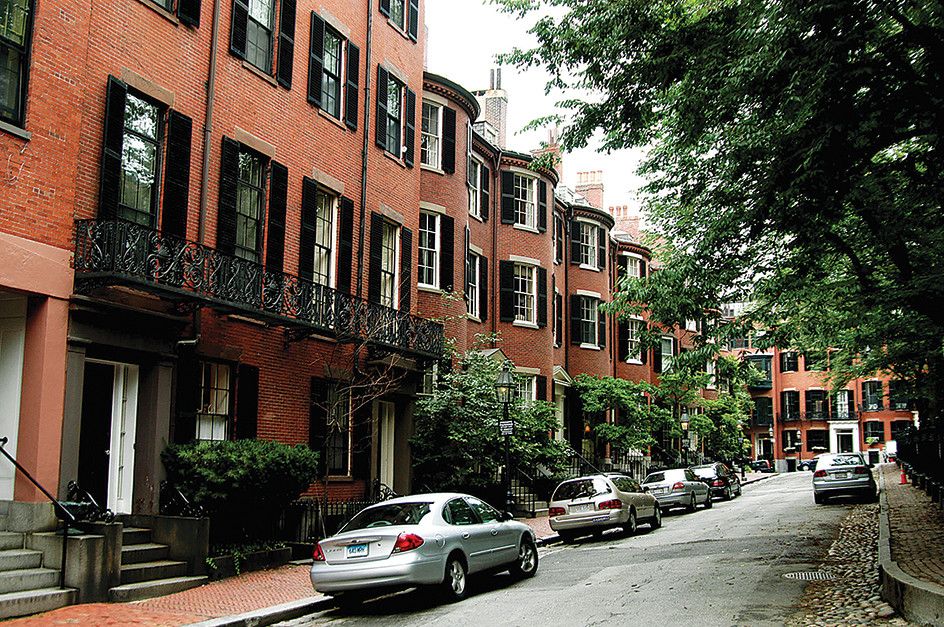
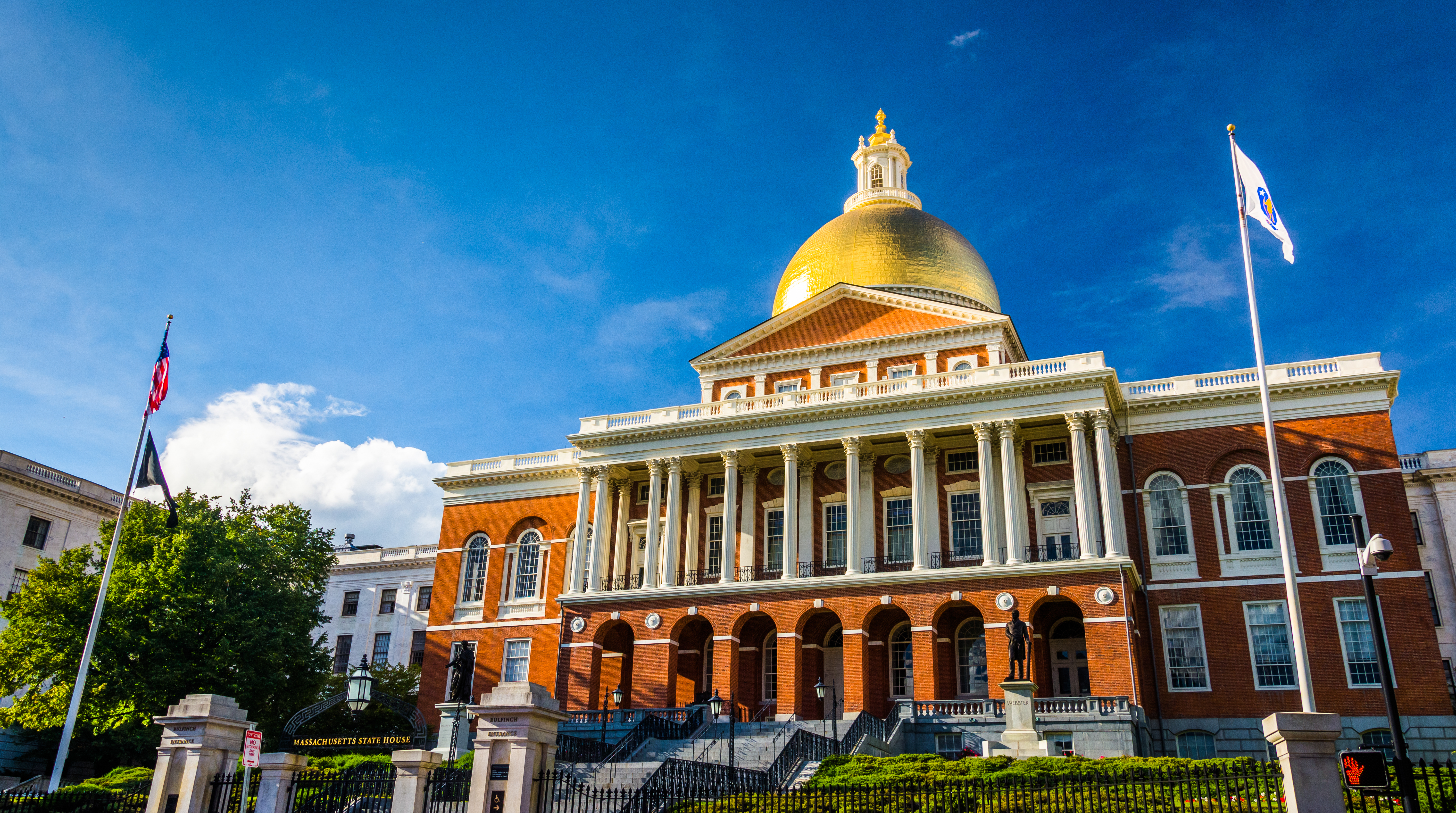
The North End
stretches along the east coast of the Shawmut peninsula. Several landmarks on the Freedom Trail, including the Old North Church, where lanterns were hung to warn of a British attack, and the house of the revolutionary leader Paul Revere, are in this area. In colonial times, ships from Europe and Asia docked at the North End. Today, warehouses and other buildings on the wharves are being remodeled into luxurious apartments.
Most people in the North End live in four-story brick apartment buildings along narrow, winding streets. Most of the community’s residents are of Italian ancestry. Many are Roman Catholics who follow some of the traditions of their ancestors. For example, many Catholic churches celebrate religious holidays with a colorful procession and festival. Money donated to the church is pinned to the garments that clothe a large statue of Jesus Christ or a saint. Several men then carry the statue through the streets, followed by marching bands and worshipers. The festival held after the procession may include carnival rides and folk dancing.
South Boston
is a large peninsula in Boston Harbor southeast of the Shawmut peninsula. Many of its residents are people of Irish descent. They feel strong ties to their families and neighborhood and take great pride in their nationality. They affectionately refer to their community as “Southie.”
Until the 1940’s, South Boston was one of the city’s industrial, shipping, and railroad centers. But many factories closed or moved to the suburbs. As a result, unemployment rose and poverty spread. In the 1980’s, however, waterfront redevelopment brought new growth. A container shipping terminal opened in 1984, and the renovation of an old pier into what is now the Seaport World Trade Center was completed in 1986.
East Boston,
another large peninsula in Boston Harbor, is the city’s northeasternmost section. It is an area of wooden row houses and three-story apartment buildings. Logan International Airport lies on the peninsula’s east side.
Charlestown
is a hilly, residential section separated from East Boston by Boston Inner Harbor. English colonists founded the town of Charlestown in 1630. Many of these colonists moved on to found Boston several months later. Charlestown became part of Boston in 1873. The U.S.S. Constitution, the famous “Old Ironsides” of the War of 1812, is docked at the Charlestown Navy Yard. Nearby stands a monument commemorating the Battle of Bunker Hill, fought in Charlestown in 1775.
Brighton-Allston
lies in northwestern Boston. Many students and families live in apartments and small houses in this neighborhood.
The south side
is made up of Roxbury, Dorchester, the South End, Mattapan, and Jamaica Plain. These communities have many old, run-down houses and apartment buildings. The area’s many African American and Hispanic churches, community theater companies, and social action groups reflect a strong sense of pride among the neighborhood’s people.
Hyde Park and West Roxbury,
with their streets of comfortable houses, resemble many New England suburbs. Many of the residents work for the city or state government.
Metropolitan area.
The Boston-Cambridge-Newton metropolitan area covers Essex, Middlesex, Norfolk, Plymouth, and Suffolk counties in Massachusetts and Rockingham and Strafford counties in New Hampshire. More than 60 percent of the population of Massachusetts and about 30 percent of New Hampshire’s people live in this metropolitan area. Boston is by far the largest city in the metropolitan area, but more than 85 percent of the people in the area live outside the city. Although Boston ranks only 25th among U.S. cities in population, its metropolitan area ranks 10th. The Boston metropolitan division covers Norfolk, Plymouth, and Suffolk counties in Massachusetts.
The Boston area includes many historic cities and towns. Cambridge, on the north bank of the Charles River, is the home of Harvard University. Harvard, founded in 1636, is the country’s oldest institution of higher learning. General George Washington first took command of the Continental Army on the Cambridge Common in 1775. Lexington, which lies northwest of Cambridge, is called “the birthplace of American liberty.” In 1775, British troops killed eight minutemen on the Lexington village green in the first battle of the Revolutionary War.
Visitors to nearby Concord can see Minute Man National Historical Park and the homes of authors Louisa May Alcott and Ralph Waldo Emerson. In Salem, northeast of Boston, 19 people accused of witchcraft were hanged on Gallows Hill during the 1690’s. Today, the city’s attractions include its quaint streets and houses, the Salem Witch Museum, and Pioneer Village.
People
English Puritans and their descendants made up almost the entire population of Boston for over 200 years after the city was founded in 1630. Some rich Puritan families produced outstanding business leaders, educators, and writers. These families were known as the Boston Brahmins. The name came from the Brahmins, or Brahmans, who make up the highest castes (social classes) of the Hindu religion. Members of many of these families still live in the area.
But Boston has been a city of immigrants since the 1840’s, when wave upon wave of Europeans began to pour into the city. Even today, Boston has a higher percentage of people born in other countries than do many other large U.S. cities.
Boston has one of the largest Roman Catholic communities in the United States. The Unitarian Universalist Association of Congregations and the Church of Christ, Scientist, have their headquarters in Boston.
Ethnic groups.
Many of Boston’s people are of Irish and Italian descent. African Americans make up one-fifth of the population. The city’s ethnic groups also include people of Hispanic and Asian ancestry.
People of Irish ancestry began to pour into Boston by the thousands from 1845 to 1847 to escape starvation caused by the failure of Ireland’s potato crop. In time, descendants of Irish immigrants gained political control in Boston. The Irish became one of the city’s most prosperous and powerful ethnic groups.
Many people of Italian ancestry arrived in Boston from 1880 to 1914. During that period, cheap steamship service linked the city with eastern and southern Europe. The low fares attracted thousands of poor Italians, as well as many Lithuanians and Poles, to Boston. Most of the Italians settled in the North End.
African Americans from the Southern States began to move to the North in ever-increasing numbers after World War I ended in 1918. But Boston’s depressed economy at that time could offer few jobs to the unemployed. Thus, fewer African Americans moved to Boston than to such cities as Chicago and Detroit, where factories were hiring many unskilled workers.
Education.
Boston is the birthplace of public education in the United States. The Boston Latin School, the first public school in the Western Hemisphere, opened in 1635. Today, the Boston School Committee governs the city’s public school system. The committee consists of seven members appointed by the mayor. The city also has many private schools.
Greater Boston is one of the nation’s leading centers of learning. It has many well-known colleges and universities. Harvard University and the Massachusetts Institute of Technology, both in Cambridge, have worldwide reputations for excellence. Other famous schools in Greater Boston include Boston College in Chestnut Hill, Brandeis University in Waltham, Tufts University in Medford, and Wellesley College in Wellesley. Institutions of higher education within the city of Boston include the Boston Architectural College, Boston University, Massachusetts College of Art and Design, Northeastern University, St. John’s Seminary, and a branch of the University of Massachusetts. The city also has a number of medical schools and junior colleges.
Social problems.
Poverty and unemployment have been serious problems in Boston. Many kinds of jobs available in the city—in business, government, and scientific research—require highly educated workers. Many other people cannot find work because most of Greater Boston’s factories have moved to suburban areas. Other problems include crumbling housing in poor neighborhoods and a severe housing shortage.
Cultural life and recreation
The arts.
Boston has long been a great cultural center. The distinguished Boston Symphony Orchestra performs from mid-September through May at Symphony Hall in Back Bay. The Boston Pops Orchestra presents concerts of light music at Symphony Hall in May and June. The Pops gives free outdoor concerts during July in Hatch Memorial Shell on the Esplanade, a park on the south bank of the Charles River. The MGM Music Hall at Fenway, next to Fenway Park, hosts popular-music concerts. The New England Conservatory of Music, the nation’s oldest music school, also offers many concerts. The Boston Ballet and the Boston Lyric Opera have won critical acclaim.
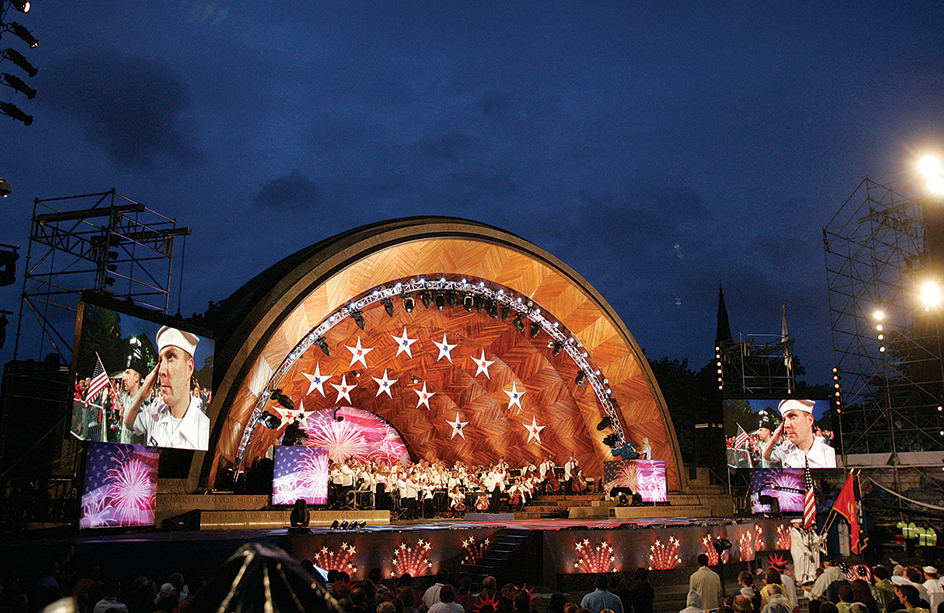
The area’s professional theater groups include the American Repertory Theater in Cambridge. In addition, dozens of community and college theater groups are active in Greater Boston.
Libraries and museums.
The Boston Public Library, founded in 1854, was the first major free library in the United States. The massive main library in Copley Square is a city landmark. The Boston Athenaeum, a small, private library in the downtown area, has many rare volumes, including books owned by George Washington, the first president of the United States. The libraries at Harvard, the Massachusetts State House, and many Boston museums attract scholars from throughout the world. The John F. Kennedy Presidential Library and Museum has papers and mementos of the 35th president of the United States.
The Museum of Fine Arts, Boston’s largest museum, stands in Back Bay. Its art collection represents nearly every culture of the last 5,000 years. The museum’s large exhibits of American art; Asian art; ancient Egyptian, Greek, and Roman art; and French Impressionist paintings are especially outstanding. Nearby, the Isabella Stewart Gardner Museum houses Renaissance paintings and sculptures in a beautifully furnished mansion. The Institute of Contemporary Art on South Boston’s waterfront and Harvard University’s Fogg Art Museum also have fine art collections.
Boston’s huge Museum of Science stands on the Charles River Dam Bridge. The museum has a dinosaur model, a machine shop, and displays of airplanes, ships, and spacecraft. The museum also includes the Charles Hayden Planetarium, which shows the movements of the stars and planets. The New England Aquarium on Central Wharf has hundreds of kinds of fish and other water animals. The Boston Children’s Museum in South Boston offers dozens of interactive exhibits and activities. The Arnold Arboretum in Jamaica Plain is a 265-acre (107-hectare) park and forest with thousands of kinds of trees and shrubs.
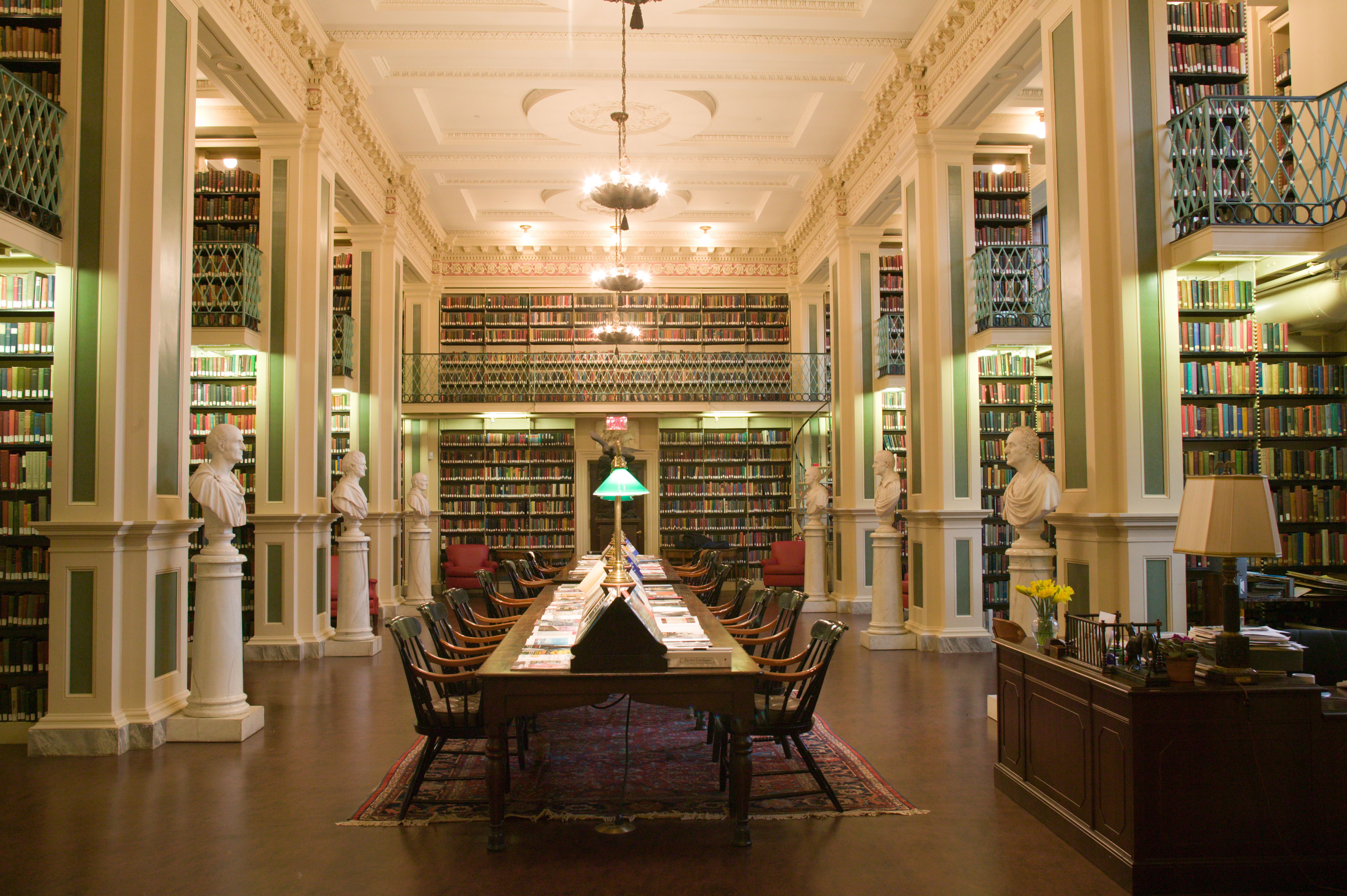
Recreation.
Franklin Park, the city’s largest park, is in Dorchester. The park includes a main zoo, a children’s zoo, and an African tropical forest. Several public bathing beaches lie along Boston Harbor in the communities of Dorchester, East Boston, and South Boston. A massive harbor sewerage project, completed in 2000, greatly improved water quality.
Bostonians are enthusiastic fans of the city’s four professional sports teams. The Boston Red Sox of baseball’s American League play in historic Fenway Park. The Boston Celtics of the National Basketball Association and the Boston Bruins of the National Hockey League also play their home games in the city. The New England Patriots of the National Football League play in a south suburban stadium.
A traditional Boston sports event takes place on Patriots’ Day, the third Monday in April. Thousands of people compete in the Boston Marathon, a foot race of 26 miles 385 yards (42.2 kilometers) from the suburb of Hopkinton to Back Bay.
Economy
Greater Boston is the largest industrial center in New England. After World War I (1914-1918), many factories moved from Boston to suburban areas where land was cheaper and more plentiful. Lynn, Quincy, and Waltham are now major industrial cities in Greater Boston.
In the city of Boston, the majority of workers have jobs in fields that provide services. For example, many people work for the area’s numerous educational institutions, medical centers, and city and state government offices. Many other workers are employed in such fields as trade, finance, transportation, and communication.
Manufacturing.
Greater Boston has thousands of factories. The area’s major products include machinery, medical and optical instruments, processed foods, and a variety of high-technology products.
Printing also ranks among the area’s important industries. Greater Boston has many book publishers, including several university presses.
Trade.
The Port of Boston includes wharves in Charlestown, in East and South Boston, and on the North End. It is a leading New England port. The chief exports include electronic equipment, office equipment, paper products, scrap iron, and seafood. Leading imports include automobiles, beer and wine, footwear, iron and steel, and petroleum products.
The Boston area is the retail and wholesale trading center of New England. Greater Boston’s retail stores employ tens of thousands of workers. Retail stores throughout New England and eastern Canada buy much of their merchandise from Greater Boston’s large number of wholesale firms.
The city of Boston ranks as one of the world’s busiest markets for wholesale wool. Boston is also a major fish market. Rich fishing waters lie off Boston’s coast.
Finance.
Boston is New England’s financial capital. The city has a stock exchange and numerous banks. The Federal Reserve Bank of Boston and many insurance companies have their headquarters in Boston. The city is a major center for trading in mutual funds.
Transportation.
Railroad freight lines and Amtrak’s rail passenger service link Boston with major cities in the United States and Canada.
Boston’s busy Logan International Airport lies less than 3 miles (5 kilometers) from downtown, on the eastern edge of East Boston.
The publicly owned Massachusetts Bay Transportation Authority (MBTA) transports hundreds of thousands of passengers each weekday in Boston and nearby cities and towns. The MBTA operates buses, streetcars, subways, trains, and trolley cars.
Boston has three main expressways—the Massachusetts Turnpike, the Northeast Expressway, and the Southeast Expressway. They extend to the suburbs and carry most of the automobile traffic to and from the downtown area.
Communication.
Boston’s Publick Occurrences Both Forreign and Domestick, published in 1690, was the first newspaper in the American Colonies. Today, Boston has two daily newspapers—The Boston Globe and the Boston Herald. Boston’s many broadcasting outlets include a nonprofit television station associated with the national Corporation for Public Broadcasting.
Government
Boston’s government is headed by a mayor and a 13-member City Council. The voters elect the mayor to a four-year term. Council members are elected to two-year terms. Nine council members are elected from districts. Four are elected by the voters on a citywide basis—that is, the members do not represent particular areas. Candidates for mayor and the City Council do not run for office under political party labels.
The mayor administers the city government and prepares the city budget. The council passes Boston’s laws and may cut, but not increase, the city budget. The mayor has the power to veto bills passed by the council. But the council can repass a bill over the mayor’s veto by a vote of two-thirds of its members. The city’s revenue comes from property taxes, state aid, and other sources.
Several regional and state government agencies provide services to Boston and many nearby cities and towns. The Massachusetts Department of Conservation and Recreation provides park and other recreational services. The Massachusetts Water Resources Authority provides a sewerage system and a water supply to participating communities for a fee. The Metropolitan Area Planning Council works to promote economic development and transportation improvement in Greater Boston.
History
Early settlement.
The Indigenous Massachusett people lived in what is now the Boston area before the first Europeans settled there in 1630. By the time the European settlers arrived, the area’s Indigenous population had been nearly wiped out by disease. From 1615 to 1617, epidemics of measles, scarlet fever, and other diseases killed about 2,500 of the 3,000 Indigenous people in the area. The diseases had been carried to the New World by European explorers.
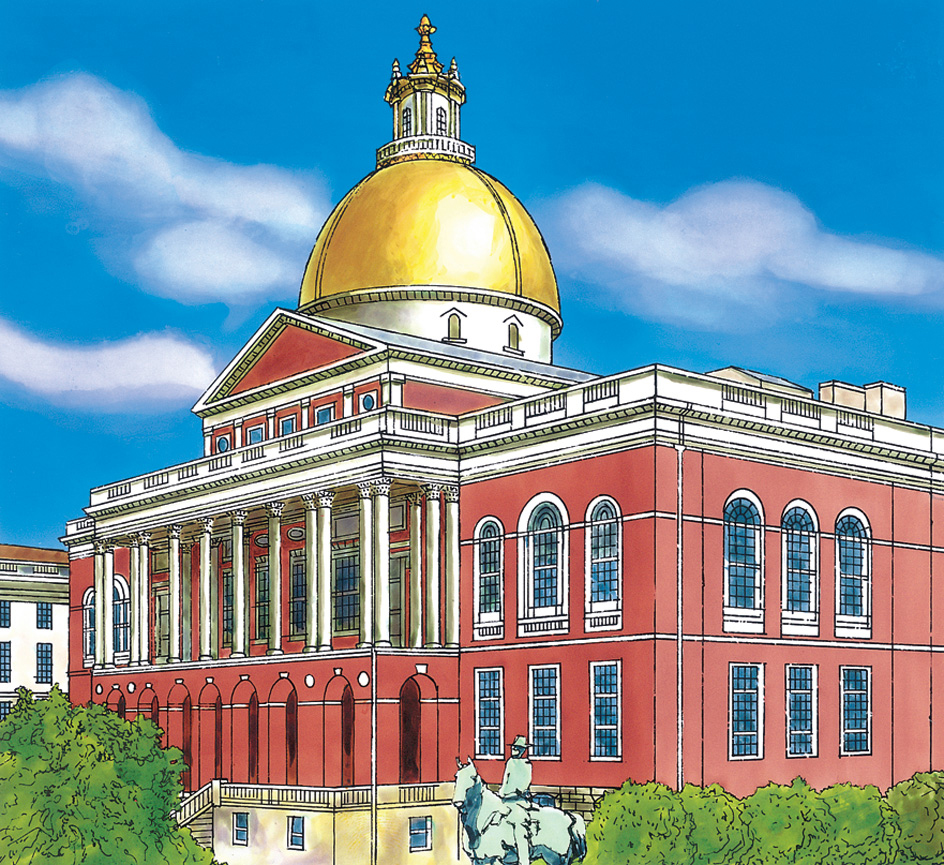
The promise of open land that could be settled without the threat of raids by Indigenous people attracted many English colonists to the Boston area. William Blackstone, the first European settler, built a cottage on what is now Beacon Hill in the 1620’s. In 1630, a group of about 800 Puritans led by John Winthrop founded Charlestown, now part of Boston. Later that year, Winthrop and many of the settlers crossed the Charles River and founded Boston on a peninsula that the Indigenous people called Shawmut. Boston became the capital of Massachusetts Bay Colony in 1632 (see Massachusetts Bay Colony).
Boston began as a tightly knit village of craftworkers, farmers, and ministers. The settlers had been persecuted in England for their Puritan beliefs. Yet the town’s leaders tried to drive out of Boston any new settlers who did not share their beliefs. Only Puritans could vote or hold public office. Laws forbade the staging of plays and the celebration of Christmas. The Puritans considered cooking on Sunday a sin. Many Puritan women prepared baked beans every Saturday and served them for Sunday dinner. This custom earned Boston the nickname Beantown.
Despite the Puritans’ restrictions, Boston grew rapidly. By 1720, it was a thriving town with about 12,000 people of various political and religious beliefs. By the mid-1700’s, Boston had become a leading commercial, fishing, and shipbuilding center of the American Colonies. Wealthy merchants were now the town leaders, and most of the strict Puritan laws were forgotten.
Resistance and revolution.
Boston’s patriots helped lead the colonies in their struggle for independence from Britain (now also called the United Kingdom). In 1765, the British Parliament passed the Stamp Act, which required the colonists to pay a tax on newspapers, legal documents, and various other items. Angry Bostonians violently protested against this “taxation without representation.” Mobs rioted and looted the homes of British officials.
In 1770, a street fight between a Boston mob and British soldiers resulted in what became known as the Boston Massacre. Soldiers fired into the mob, killing five men and wounding six others. The incident further embittered the colonists.
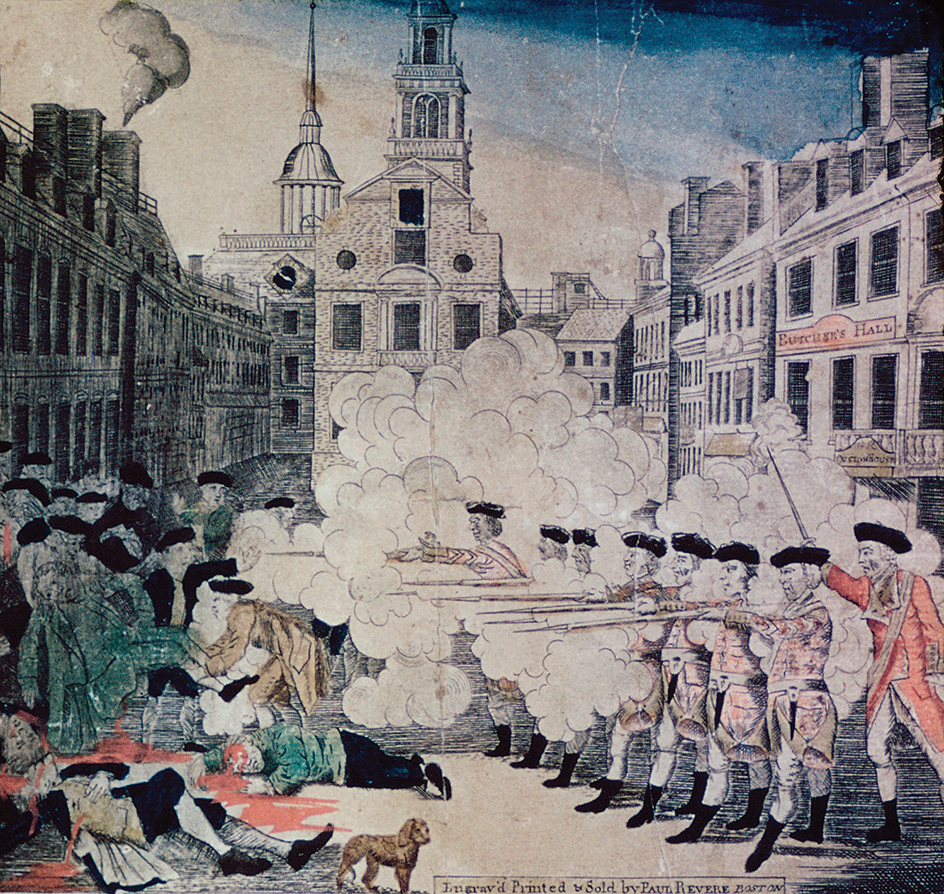
In 1773, a band of colonists staged the Boston Tea Party to protest a British tax on imported tea. Bostonians disguised as Indigenous people crept onto British ships in Boston Harbor and dumped their cargoes of tea overboard. Three major clashes with British troops—the battles of Lexington, Concord, and Bunker Hill—occurred near Boston in 1775. In March 1776, General George Washington ordered his troops to occupy Dorchester Heights, which overlooks Boston. From Dorchester Heights, the patriots threatened to fire cannon at the British troops guarding Boston. This forced the British to flee the city. The capture of Boston was the first major American victory of the revolution.
Economic growth.
After the Revolutionary War ended in 1783, Boston merchants began to build huge fortunes through foreign trade. Ships loaded with fish, rum, salt, and tobacco left Boston Harbor for ports throughout the world. The ships returned with silk and tea from China, sugar and molasses from the Caribbean, and gold and mahogany from Africa.
Boston was chartered as a city in 1822. Between 1824 and 1858, several landfill projects more than doubled the size of the Shawmut peninsula. The rapid growth of Boston’s garment, leather goods, and machinery industries made the city one of the nation’s leading manufacturing centers. 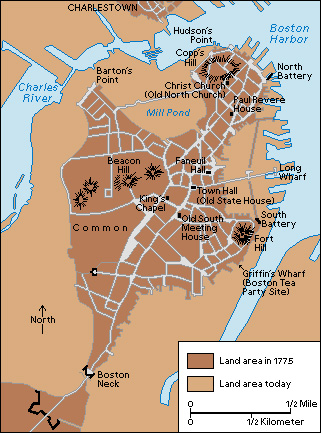
During the 1840’s, more than 500,000 Irish immigrants fled to Boston to escape starvation in their homeland, where the potato crop had failed. The immigrants provided cheap labor for the city’s factories, railroads, and wharves. Most of them lived in crowded, crime-ridden slums and faced discrimination and hostility from native Bostonians.
Boston became a center of literary activity during the 1800’s. Such famous authors as Louisa May Alcott, Ralph Waldo Emerson, Nathaniel Hawthorne, and Henry Wadsworth Longfellow lived there and became close friends. William Lloyd Garrison started a powerful antislavery movement in Boston in the 1830’s. His fiery newspaper, The Liberator, and Harriet Beecher Stowe’s antislavery novel, Uncle Tom’s Cabin, were both published in Boston.
On Nov. 9, 1872, a fire wiped out about 60 acres (24 hectares) of downtown Boston. The area was soon rebuilt, and the city continued to grow. The nation’s first subway opened in Boston in 1897. By 1900, the city’s population had reached about 560,000.
Rise of Irish politicians.
In the early 1900’s, the descendants of Irish immigrants began to dominate Boston’s politics. John F. (Honey Fitz) Fitzgerald, grandfather of President John F. Kennedy, served two terms as Boston’s mayor, in 1906 and 1907 and from 1910 to 1914. During his terms, the city enlarged City Hall, modernized the Port of Boston, and built the Franklin Park Zoo. James Michael Curley, another powerful Irish politician, served four terms as mayor between 1914 and 1950. After taking office, both men found or made jobs for their Irish supporters and so increased the economic and political power of the city’s Irish people.
Decline and urban renewal.
During the 1940’s and 1950’s, a new system of highways and expressways was built in and around Boston. But the business district and some neighborhoods in the city declined. Thousands of families and businesses moved to the suburbs. Boston’s population dropped from more than 800,000 in 1950 to about 563,000 in 1980.
A large-scale urban renewal program began in the early 1960’s. The city, state, and federal governments spent about $465 million to improve more than 2,500 acres (1,010 hectares) of land. The program included the construction of Government Center and Prudential Center and the remodeling of run-down housing in many neighborhoods. A major building and restoration program began in the residential section just south of the downtown area in the mid-1970’s.
Conflict over schools.
In June 1974, a federal court ruled that the Boston School Committee had deliberately maintained racial segregation in the city’s public school system. The court ordered the immediate desegregation of Boston’s public schools. But in the fall, more than 10 percent of the city’s public school students did not register for classes. Many who registered stayed away after fights broke out between Black people and white people in school and on nearby streets. A total integration program begun in September 1975 required the busing of over a fourth of Boston’s public school students. Some white parents protested violently and enrolled their children in private schools.
In the 1990’s, state and city officials pressed school reform efforts, and public school enrollment began to grow again. In 1999, the Boston School Committee voted to end race-based school busing.
Building boom.
In the early 1980’s, Boston’s downtown area experienced a construction boom. A number of office and residential buildings went up. The new construction, combined with the high cost of commuting and Boston’s lowered property taxes, made city living attractive. The decline in Boston’s population stopped. By 1990, the population had reached 574,283.
Work began in the early 1990’s on an enormous and costly public works project that was called the “Big Dig.” The goal of the project was to replace the elevated 6-lane Central Artery, the section of Interstate 93 that cut through downtown, with an underground highway of 8 to 10 lanes.
One phase of the project was completed in 1995 when the Ted Williams Tunnel under Boston Harbor opened. The tunnel, named for the famous Boston Red Sox ballplayer, connected the Massachusetts Turnpike with Logan International Airport. In 2003, the underground highway replacing the Central Artery opened for traffic. From 2005 to 2008, the 13-acre (5-hectare) Rose Fitzgerald Kennedy Greenway was constructed where the Central Artery had stood. The Greenway consists of four sections of parkland—Chinatown Park, Dewey Square Parks, Wharf District Parks, and North End Parks.
Developments in the early 2000’s.
The massive Boston Convention & Exhibition Center was built in South Boston in the early 2000’s. Work also took place on a residential and office development along Boston Harbor between the convention center and downtown Boston. These major construction projects, the Big Dig, and thriving businesses provided many jobs for Boston workers. By 2020, Boston’s population had increased to 675,647.
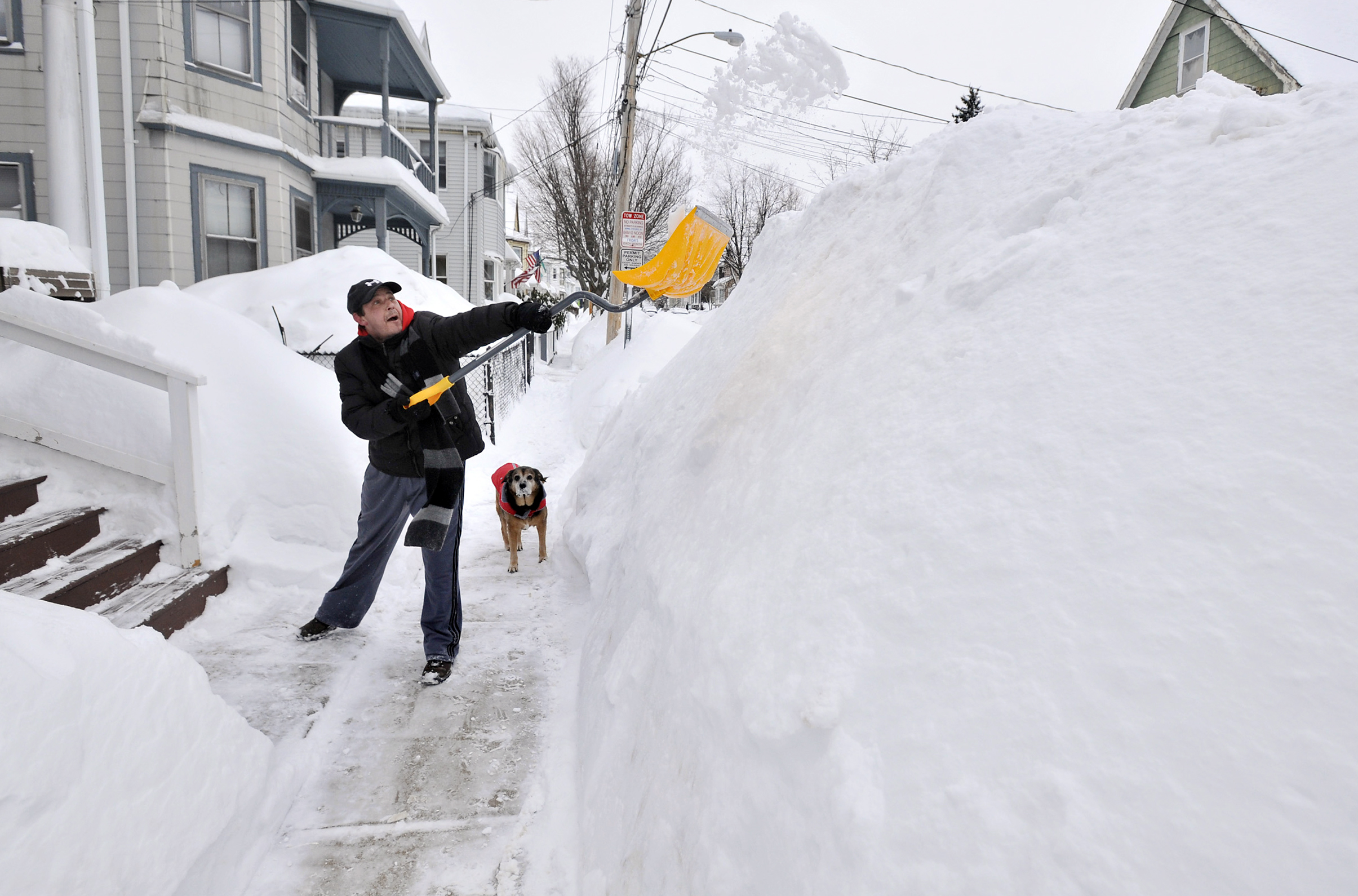
The running of the Boston Marathon ended in tragedy on April 15, 2013. Terrorists exploded homemade bombs near the finish line of the historic foot race, killing 3 and injuring more than 200. After the bombing, the two terrorist suspects—brothers Tamerlan and Dzhokhar Tsarnaev—killed a law enforcement officer and wounded several others. On April 19, Tamerlan Tsarnaev was killed, and his brother was captured. In April 2015, a federal jury found Dzhokhar Tsarnaev guilty of all charges brought against him in connection with the bombing. The jury sentenced him to death in May. A federal appeals court overturned Tsarnaev’s death sentence in 2020 and ordered a new penalty phase to the trial. In 2022, however, the Supreme Court of the United States reinstated Tsarnaev’s death sentence.
Voters elected Michelle Wu mayor in November 2021. She became the first woman and first non-white person to hold the office.
